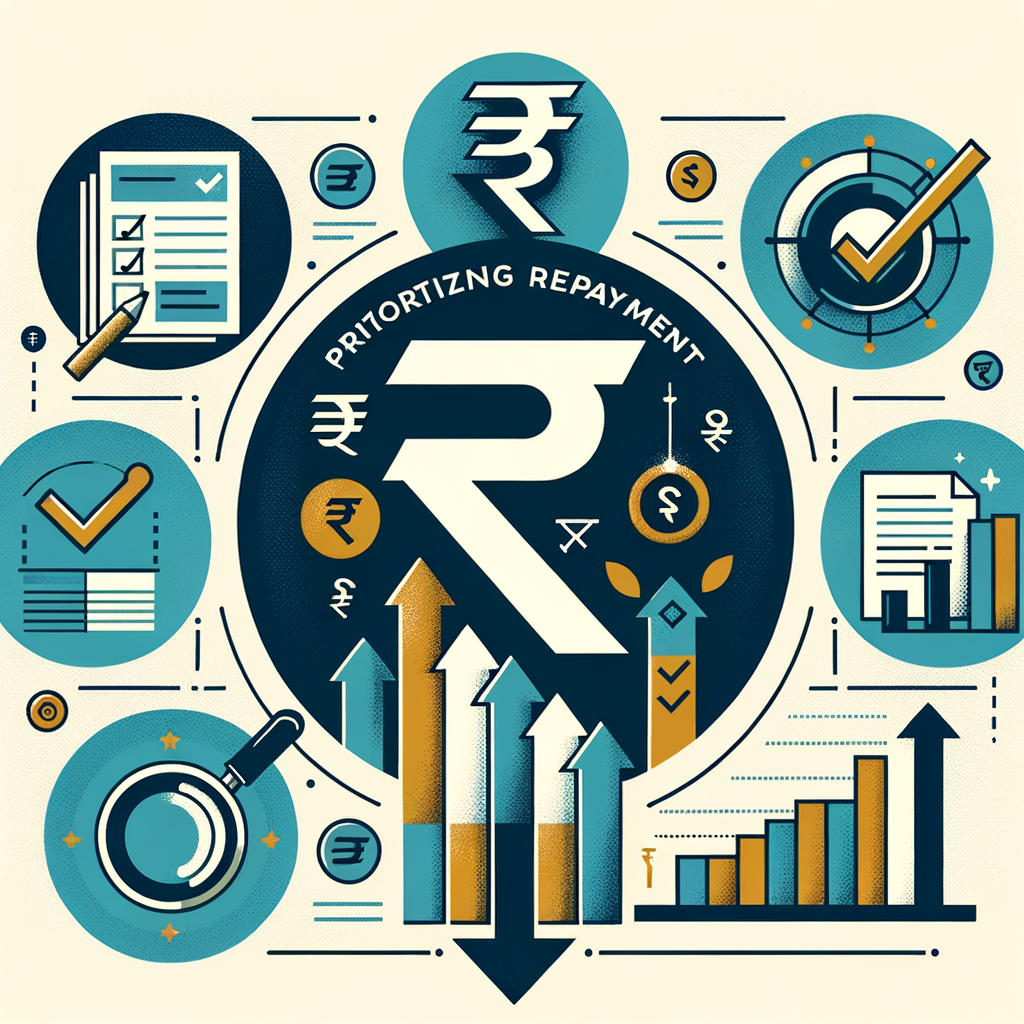Prioritizing Debt Repayment: A Comprehensive Guide for Indians
Feeling crushed under the weight of multiple EMIs? The constant alerts for credit card bills, personal loan payments, and home loan installments can be incredibly stressful, making financial freedom seem like a distant dream. Many Indians, whether salaried individuals or small business owners, find themselves in this exact situation. However, breaking free from this cycle is possible with a structured plan and unwavering discipline. This article is designed to be your comprehensive debt repayment guide, offering a clear roadmap to navigate your liabilities. This prioritize debt repayment guide India will walk you through understanding your financial obligations, choosing the right strategy, and implementing practical steps to pay off what you owe and reclaim your financial future.
Step 1: Understand and List All Your Debts
The first and most crucial of all steps for debt repayment in India is to face the numbers head-on. It can be intimidating to see the total amount you owe, but avoiding it will only worsen the situation. Gaining a complete and honest picture of your debt is the only way to create an effective plan to tackle it. The goal is to move from a state of anxiety to one of control, where you are the one dictating terms to your debt, not the other way around. To do this, you need to create a master list or a simple spreadsheet that captures every single rupee you owe. This document will become your single source of truth and the foundation upon which your entire debt-free journey is built.
What to Include for Each Debt
For your master list to be truly effective, it needs to be detailed. Gather all your loan statements and credit card bills and meticulously record the following information for each outstanding loan or credit line:
- Lender Name: Clearly state who you owe money to (e.g., HDFC Bank, SBI, Bajaj Finserv, a local lender).
- Type of Debt: Categorize each liability (e.g., Credit Card, Personal Loan, Home Loan, Business Loan, Car Loan).
- Outstanding Principal Amount: This is the total capital amount you still need to pay back.
- Interest Rate (p.a.): This is arguably the most critical piece of information. The interest rate determines how quickly your debt grows and how much it costs you over time.
- Minimum Monthly Payment (EMI): Note down the mandatory amount you are required to pay each month.
- Loan Tenure Remaining: Calculate how many months or years are left until the debt is fully paid off at the current rate.
Once you have this list, organize it. Sort all your debts from the one with the highest interest rate to the one with the lowest. High-interest debt, like credit card debt, is the most destructive to your wealth and should be your primary target.
Step 2: Create a Realistic Budget to Free Up Cash
Once you know exactly what you owe, the next step is to figure out how much you can afford to pay. This is where budgeting becomes non-negotiable. A budget is simply a plan for your money; it tells your income where to go instead of you wondering where it went. Creating a realistic budget is the cornerstone of all sound debt management tips for Indians, as it helps you identify areas where you can cut back on spending and redirect that cash towards your debt. Without a budget, you are flying blind, making it nearly impossible to consistently find extra money to accelerate your repayment schedule. It’s about making conscious choices with your money to achieve your long-term goal of becoming debt-free.
The 50/30/20 Rule for Indians
A popular and effective budgeting framework is the 50/30/20 rule. It provides a simple yet powerful way to allocate your post-tax income:
- 50% for Needs: This portion of your income should cover your absolute essentials. This includes your rent or home loan EMI, grocery bills, utility payments (electricity, water, gas), transportation costs, and mandatory insurance premiums. These are the expenses you cannot avoid.
- 30% for Wants: This category is for your lifestyle expenses—things that are nice to have but not essential for survival. This includes dining out, entertainment like movies or subscriptions, shopping for non-essentials, and travel. When you need to free up cash for debt repayment, this is the first and most flexible category to trim down.
- 20% for Savings & Debt Repayment: This is the portion of your income dedicated to building your future and clearing your past. Your goal should be to maximize this allocation. While you’re aggressively paying down debt, a larger percentage of this slice will go towards your loans.
To get started, track your expenses for a month using a simple diary or modern apps like Walnut or Money Manager. For small business owners, this step involves the critical discipline of separating personal and business finances and carefully reviewing business cash flow to identify potential savings.
Choosing Your Strategy: The Best Debt Repayment Strategies in India
With a clear picture of your debts and a budget in place, it’s time to choose your battle plan. There are several effective debt repayment techniques India, but two of the most popular and proven methods are the Debt Avalanche and the Debt Snowball. Your choice between them depends entirely on your personality and what motivates you. One method is mathematically superior, while the other provides powerful psychological boosts that help you stay on track. There is no single “best” strategy for everyone; the best one is the one you can stick with consistently. For a detailed breakdown, see our guide on Debt Snowball vs. Debt Avalanche: Which Strategy Is Best for You?.
| Feature | Debt Avalanche Method | Debt Snowball Method |
|---|---|---|
| Focus | Highest Interest Rate Debt First | Smallest Debt Balance First |
| Process | Pay minimum on all debts. Use all extra cash to attack the debt with the highest interest rate. | Pay minimum on all debts. Use all extra cash to attack the debt with the smallest balance. |
| Primary Advantage | Saves the most money on interest payments over the long term. | Builds momentum and provides quick psychological wins, increasing motivation. |
| Best For | Disciplined individuals motivated by logic and numbers. | Individuals who need to see quick progress to stay committed and motivated. |
The Debt Avalanche Method (Interest Rate-Focused)
The Debt Avalanche method is the most efficient strategy from a purely financial perspective. The logic is simple: high-interest debt costs you the most money, so you should eliminate it as quickly as possible.
- How it works: You continue to make the minimum required payments on all your loans. Then, you allocate every extra rupee you’ve freed up from your budget towards the loan with the highest annual interest rate. Once that debt is completely paid off, you roll the entire payment amount (its minimum payment plus the extra cash) into the loan with the next-highest interest rate.
- Example: Imagine you have a credit card debt of ₹1,00,000 at 36% p.a. and a personal loan of ₹3,00,000 at 14% p.a. Even though the personal loan balance is larger, you would focus all your extra repayment efforts on the credit card because its interest rate is financially toxic. This approach ensures you pay the least amount of interest over the life of your loans.
The Debt Snowball Method (Momentum-Focused)
The Debt Snowball method prioritizes motivation over mathematics. The strategy is built on the idea that small, quick wins can provide the psychological momentum needed to tackle larger challenges. For many, seeing a loan completely disappear provides a powerful boost to continue the journey.
- How it works: You make the minimum payments on all your debts. Then, you direct all your extra money towards paying off the loan with the smallest outstanding balance, regardless of its interest rate. Once that smallest debt is cleared, you feel a sense of accomplishment. You then take the full amount you were paying on that cleared debt and “roll” it into the payment for the next-smallest debt, creating a growing “snowball” of repayment.
- Example: Suppose you have a consumer durable loan of ₹20,000 at 16% and a personal loan of ₹2,00,000 at 14%. With the Snowball method, you would aggressively pay off the ₹20,000 loan first. Eliminating an entire loan account quickly can be incredibly empowering and helps you build the habit and confidence to tackle the bigger loans next.
How to Reduce Debt in India: Actionable Tips
Choosing a strategy is essential, but you can further accelerate your progress with a few practical actions. These debt management tips for Indians are designed to help you optimize your finances and channel even more money towards becoming debt-free.
Consider Debt Consolidation or Balance Transfer
If you’re juggling multiple high-interest debts, especially credit card bills, debt consolidation could be a powerful tool. You can learn more in The Ultimate Guide to Debt Consolidation Loans. This involves taking out a new, single loan (often a personal loan) at a lower interest rate to pay off all your other expensive debts. This simplifies your finances into one EMI and, more importantly, reduces the total interest you pay. Another option is a credit card balance transfer, where you move your outstanding balance from a high-interest card to a new one offering a 0% or low-interest promotional period.
Caution: Before you commit, carefully calculate the total cost. Check for processing fees on the new loan and ensure the new interest rate is genuinely lower than the weighted average of your existing debts.
Increase Your Income
While cutting costs is crucial, there’s a limit to how much you can save. Increasing your income, on the other hand, is limitless. For salaried individuals, this could mean seeking a salary hike, taking on freelance projects in your area of expertise, or starting a side hustle that aligns with your passion. For small business owners, this is an opportunity to explore new revenue streams, optimize your pricing strategy, or launch new products or services. Every extra rupee earned can be a powerful weapon aimed directly at your debt principal.
For Salaried Individuals: Leverage Annual Bonuses and Increments
This is one of the most effective debt repayment methods for salaried individuals. When you receive an annual bonus or a salary increment, resist the temptation to upgrade your lifestyle immediately. Instead, treat this windfall as a golden opportunity to make a significant dent in your debt. Commit to using a large portion—say, 50% or more—of this extra cash to make a lump-sum prepayment on your highest-interest loan. This single action can shave months or even years off your loan tenure and save you a substantial amount in interest.
Avoid Taking on New Debt
This may sound obvious, but it’s a critical rule to follow while you are in repayment mode. You cannot get out of a hole by digging deeper. Put a temporary pause on taking new loans or making large purchases on credit. Make a conscious effort to switch to using your debit card or UPI for daily expenses. This forces you to spend only the money you actually have, breaking the cycle of borrowing and helping you stay focused on your primary goal of clearing existing liabilities.
Check Your Credit Score
Your CIBIL score is a three-digit summary of your credit history and plays a vital role in your financial life. A high credit score (typically 750 or above) demonstrates that you are a responsible borrower. This can be a huge asset when you’re looking to consolidate debt, as lenders are more likely to offer you a new loan at a favorable, lower interest rate. We have a detailed guide on How to Track Your Credit History Using Your PAN Card Via CIBIL. You can check your score on official portals like the CIBIL website. Regularly monitoring your score is a healthy financial habit.
Conclusion
Embarking on the path to becoming debt-free is one of the most empowering financial decisions you can make. The journey requires clarity, a solid plan, and consistent effort. By following the essential steps outlined in this debt repayment guide—listing all your debts, creating a workable budget, choosing a repayment strategy like the Avalanche or Snowball method, and applying actionable tips—you can systematically dismantle your debt and build a foundation for lasting financial health. Remember, the key is to start now and stay disciplined.
Feeling overwhelmed? Crafting comprehensive debt repayment plans India requires expertise. Don’t navigate this journey alone. Contact TaxRobo’s financial advisors today for a personalized strategy to manage your finances and accelerate your journey to being debt-free.
Frequently Asked Questions (FAQ)
1. Should I stop my SIP investments to repay my debt faster?
Answer: This is a common dilemma and depends on a simple comparison of interest rates. If your debt has a very high interest rate (e.g., a credit card at 30-40% p.a.), which is significantly higher than your expected investment returns from SIPs (e.g., equity mutual funds at 12-15% p.a.), it is mathematically wiser to pause your SIPs and prioritize clearing that high-cost debt. However, for low-interest, wealth-creating debt like a home loan (8-9% p.a.), it might be better to continue your SIPs, as your investment returns are likely to outperform the loan’s interest cost over the long term. A balanced approach is often the best solution.
2. What is the difference between debt settlement and debt consolidation in India?
Answer: Debt consolidation and debt settlement are very different. Debt consolidation is the process of combining multiple debts into a single, new loan, ideally with a lower interest rate. This is a proactive financial strategy that simplifies payments and can save you money on interest without negatively impacting your credit score if managed well. Debt settlement, on the other hand, involves negotiating with your lender to pay back a lump sum that is less than the total amount you owe. This is usually considered a last resort when you are unable to pay your debts and will severely damage your credit score for up to seven years, making it very difficult to get loans in the future.
3. How does prepaying a home loan in India work? Does it have any charges?
Answer: Prepaying a home loan allows you to pay back a part or the entire outstanding principal amount before the end of the loan tenure. This reduces your principal, which in turn reduces the total interest you pay over the life of the loan. As per RBI guidelines, lending institutions cannot charge a prepayment penalty or foreclosure charges on floating-rate home loans given to individual borrowers. However, if you have a fixed-rate home loan, the lender may still levy a prepayment penalty. It is always best to read your loan agreement carefully or speak to your lender to understand the specific terms and conditions.
4. As a small business owner, should I use personal funds to pay off business debt?
Answer: This is a complex decision with significant implications. Using personal funds to clear business debt can sometimes be necessary to save a struggling enterprise, especially if you have provided a personal guarantee for the loan. However, it blurs the critical line between your personal and business finances, putting your personal assets (like your home or savings) at risk if the business continues to face financial trouble. Before making such a move, it is crucial to conduct a thorough assessment of the business’s long-term viability and cash flow projections. Consulting with a professional is highly recommended. A financial advisor from a firm like TaxRobo can help you evaluate the situation and make an informed decision.



